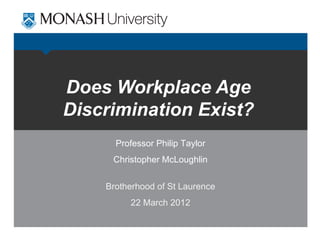
Everyday Discrimination
- 1. Does Workplace Age Discrimination Exist? Professor Philip Taylor Christopher McLoughlin Brotherhood of St Laurence 22 March 2012
- 2. Today’s presentation Background on our research and the concept work ability Describe our current research activities Preview upcoming developments in work ability research. 2
- 4. Work ability: Development Work ability is an indication of how well a person’s health, skills and experience match the demands of their job. Developed by the Finnish Institute of Occupational Health – 30 year longitudinal study – Work Ability Index (WAI) – Framework for work ability promotion – International symposia – Evolving theoretical model 4
- 5. The holistic model of work ability 5
- 6. The holistic model of work ability 6
- 7. Utility of the work ability construct Driven by economic imperatives to contain costs arising from population ageing, governments internationally are aiming to increase participation by older workers. Inter-related factors determine the relationship between older people and the labour market. Consensus that tackling the issue requires multi-faceted and integrated strategies. Work ability construct and a framework for its workplace promotion offers such an approach. Sustaining high levels of workforce participation by older workers will depend in part on efforts to ensure that work ability is maintained over a working life. 7
- 8. Section 2: Current Activities 8
- 9. Work Ability Survey Revised (WAS-R) Monash University, Sydney University, Swinburne University and Safe Work Australia Nationally representative sample of workers (n ≈ 3200) Methodologically sound approach to scale development Improved coverage of operationalisable elements of the conceptual model Current status: – Data collection completed – Completing modelling analyses – Examining the relationship between elements of work ability and demographic and other factors. 9
- 10. Theoretical model 10
- 11. Experiences of everyday discrimination The experience of behaviours labelled ‘everyday discrimination’ in the workplace was assessed across 12 items, with significant variation in the frequency of occurrence. Between 10-50% of participants reported experiencing these behaviours in the workplace over the last 12 months. The most commonly reported of the 12 was ‘receiving insufficient information to do your job properly’ and the most infrequently reported behaviour was ‘your property being damaged’. On average, 25% of respondents reported experiencing these behaviours at work. 11
- 12. Experiences of everyday discrimination Receiving insufficient information to do your job properly 54% Being ignored by your colleagues or treated as if you didn’t exist 31% Not getting the opportunities you needed to be competitive for promotions 27% Your work performance being evaluated unfairly 26% Not getting privileges others received 25% Being left out of a social gathering at work 23% Being excluded from a work meeting 22% Feeling as though you were being pushed out 22% Being passed over for promotion 20% Insulting jokes or comments 20% Being set up for failure 17% Your property being damaged 10% 12
- 14. Relationship between age and everyday discrimination One-way ANOVA applied to investigate the association between age and reports of everyday discrimination. Considering two typologies of discriminatory behaviour, social and advancement discrimination, the average reported frequency of such behaviours was compared across the age groups: 18-24, 25-34, 35-44, 45-54, 55-64 and 65+. No statistically significant difference observed in terms of social discrimination (f(5, 2861) =1.99, p=0.077). In the case of advancement discrimination, a statistically significant mean difference was detected (f 5, 2861) =2.23, p=0.048). Those aged under 65 reported a homogenous frequency of experiences. Those over age 65, on average, reported fewer experiences of advancement discrimination than those aged 24-54. 14
- 15. Relationship between age and everyday discrimination Dunnett’s T3 post hoc comparisons indicated that participants aged 18-24 (M=4.5, SD=1.0) were more likely to experience insulting jokes and comments than those aged 55-64 (M=4.7, SD=0.8). Dunnett’s T3 post hoc comparisons indicated that participants aged 25-54 (M=3.8, SD=1.2) more frequently reported receiving insufficient information to do their job properly than those aged 55-64 (M=4.1, SD=1.1). Dunnett’s T3 post hoc comparisons indicated that participants aged 35-54 (M=4.4, SD=1.0) more frequently reported having their work performance evaluated unfairly than those aged 65+ (M=4.8, SD=0.7). No age differences observed for the item: ‘Feeling as though you were being pushed out’. 15
- 16. Work Ability Survey Revised (WAS-R) Next steps: – Complete modelling process – Delve into; industry, sectorial, occupational, organisation type, gender, age, socio-economic position and work ability. Future directions – Benchmark WAS-R scores for Australian workers – Extend project through longitudinal design – Refine measure – responding to data and method advances – Track changes in work ability over time and developing international comparative data. 16
- 17. Thank you Professor Philip Taylor philip.taylor@monash.edu 17